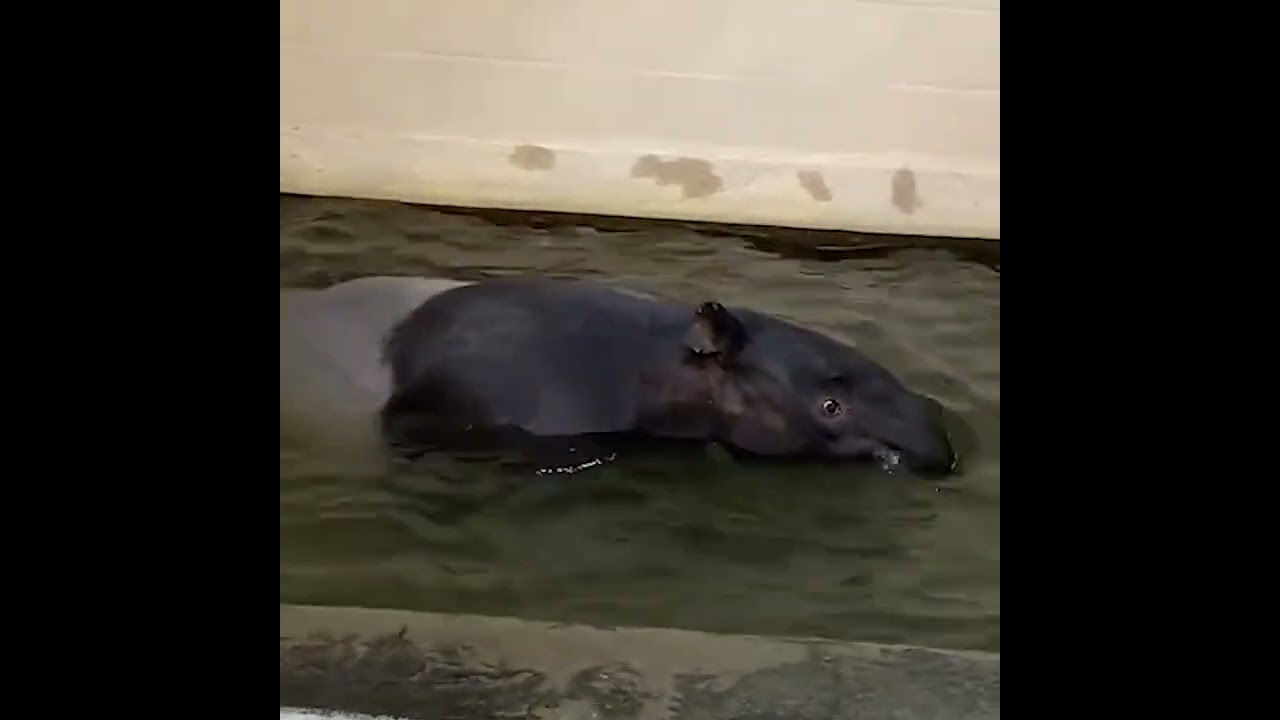- The physiological and behavioral characteristics of tapirs, focusing on their adaptations and life cycle during pregnancy.
- An exploration of tapir anatomy and their aquatic behaviors that make bath time an essential activity for pregnant tapirs.
- The role of bathing in maintaining the health and well-being of tapirs in captivity, emphasizing zoo management practices.
- Insights into tapir conservation efforts, challenges involved, and the importance of preserving their natural habitats.
- Observations and analysis of video material depicting pregnant tapirs enjoying bath time, highlighting their behaviors and interactions.
Tapirs, related to horses and rhinoceroses, are unique creatures that provide a window into evolution’s slow dance with their blend of primitive and modern features. This article explores the fascinating life of a pregnant tapir, specifically emphasizing the joy she derives from bath time. Tapirs are known for their snout, which resembles an elephant’s trunk, a tool adapted for grabbing foliage and reaching water. Pregnancy is a critical period where a female’s behavioral and physiological needs heighten, demanding extra attention especially in captivity.
Technically, tapirs are perissodactyls—odd-toed ungulates, implying their hooves are complex structures supporting them through various terrains. During pregnancy, tapirs exhibit subtle behavioral changes. They become more reclusive, a natural instinct to protect the unborn against predators in the wild, and their visits to water sources increase. Water helps regulate their body temperature, eases the stress of carrying extra weight, and importantly, assists in mobility. A pregnant tapir’s center of gravity shifts, affecting her ability to move. Bath time, therefore, plays a psychological role, offering moments of relief and therapeutic peace.
The anatomy of tapirs plays a substantial role in their love of water. Their thick skin serves as armor against biting insects common in tropical environments. Bathing helps eliminate these pests, which can be aggravating, more so for a creature already handling the physical demands of pregnancy. Tapirs have short yet muscular bodies with limbs adapted for wading through water. Their clever use of rivers and ponds for escape, refreshment, and grooming highlights their profound connection with aquatic habitats.
In captivity, zoo environments aim to replicate the natural settings crucial for the well-being of tapirs. Zoo management teams are tasked with providing enrichment that caters to their behavioral needs. A pregnant tapir requires access to spacious enclosures with ample water bodies to lounge and bathe. These water features simulate their native habitat, vital for stress relief and comfort. Regular monitoring ensures that water quality remains high, given that cleanliness is essential to prevent infections, which are particularly risky during pregnancy.
Observing a pregnant tapir’s bath time is a glimpse into the animal’s instinctual joy. Videos often reflect a gentle interaction with water, showcasing their playfulness. They submerge and resurface, an action helping cool their bodies, while the submersed sections receive necessary relief from the sun’s harsh rays.
Efforts to conserve tapirs face numerous challenges. These creatures reside mainly in the rainforests of South and Central America and Southeast Asia—regions plagued by logging and agricultural expansion. Conservationists work tirelessly to protect these natural habitats. Captive breeding programs serve as a safety net against the backdrop of environmental destruction and poaching risks. These programs prioritize the reproduction and care of pregnant females, considering the alarming decline of tapir populations.
Worldwide, the effort to preserve tapir populations emphasizes the importance of maintaining biodiversity. They are often described as “gardeners of the forest,” dispersing seeds through their droppings and sustaining forest regeneration. Hence, a focus on the health of pregnant tapirs—including their favored bath time—plays into larger ecological strategies. Balancing water access and quality alongside nutritional support and medical care ensures these gentle creatures continue to thrive in a narrowing space.
Through recorded footage, the behavior of a pregnant tapir enjoying bath time allows both enthusiasts and experts to better understand their character. Such videos are not only captivating but also educational, fostering a deeper appreciation for the species and underscoring the need for sustained conservation efforts. Seeing a pregnant tapir relishing her time in water reaffirms our commitment to securing a future where these ancient creatures continue to roam.
The role of comprehensive zoo management in preserving the health of tapirs cannot be overstated. For pregnant tapirs, bath time is a cherished ritual, aiding their physical comfort and happiness. It is central to their story of survival, encompassing aspects from their unique anatomy to the challenges they face in a changing world. Through dedicated conservation efforts and public education, the future of tapirs can be bright, allowing them, even in captivity, to enjoy the simple pleasures of life like a refreshing bath.
*****
Source Description
Yuna, our pregnant tapir, is enjoying some behind-the-scenes private bath time and resting when needed. Staff can see the baby moving around, and Yuna’s recent ultrasound revealed healthy movement and heartbeat. Yuna and soon-to-be father Baku are part of the Species Survival Plan, a managed breeding program for endangered Malayan tapirs. After a 13-month gestation period, a single tapir baby, called a calf, is born—twins are very rare.
📹: Keeper Chrissy


